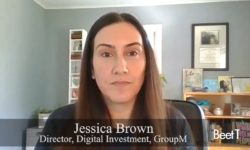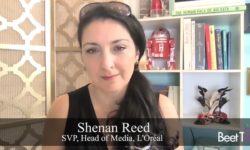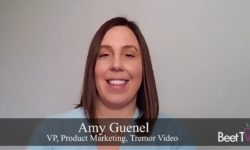Brands want to advertise in connected TV environments, and publishers there are eager to earn what can be higher CPMs.
But, for that opportunity to reach its potential, the industry is going to have to give both parties the metrics they need to prove effectiveness.
In this video interview with Beet.TV, Remove term: Matt Mclaughlin of DoubleVerify says connected TV can learn a thing or two from mobile.
From mobile to TV
DoubleVerify has been working to bring Authenticated Impressions, its KPI for campaign effectiveness, from other digital platforms to connected TV.
“I think we learned early from the mobile space that it’s really important for brands and their media buying teams to be able to do it in a scalable way,” McLaughlin says.
“I think we all know there’s challenges or differences in the environment around things like measuring viewability, how do you determine the context that you’re appearing next to.
“We’re really focused on solving those challenges in a scalable way, because it is the minimum standard of quality for impressions that a brand should pay for.”
One tag to rule them all
McLaughlin acknowledges the challenges. For one, unlike mobile, which has basically two main operating systems, there is a plethora of emerging OTT TV platforms.
His company is redeploying Video OmniTag – a system that combines OMID, VPAID and other video measurement tags into a single VAST tag, across device channels – on connected TV.
“The same Video OmniTag we have works no matter whether you’re in desktop, mobile app space, mobile web space or connected TV,” McLaughlin says.
“That’s key for operational efficiency for brands so that they can conduct measurement using a single video campaign and, no matter what, whether it’s a direct buy, a programmatic buy, what type of environment they’re appearing inside, the same measurement tag and solution works for them.”
This report is our best ever. Check it out if you have the chance… https://t.co/TLv4yjhQST
— Matt McLaughlin (@MattMcLaughlin) August 19, 2020
Safety on screen
Beyond measurement, however, ad buyers are asking for further capability. They want to ensure the connected TV environments in which they appear are appropriate.
That’s because a growing proportion of connected TV ads are bought programmatically, in automated fashion. Now advertisers want to have a little more control.
“Brands are asking us for content level controls, understanding the specific content,” McLaughlin says.
“If there’s a show or an episode that they’re appearing alongside, they want the transparency and the control so that they can ensure their placements are effective and representative of their brand values.”
Fighting fraud
And, despite the perception that connected TV is immune to the ad fraud that has plagued other digital channels – which sees bots fake human traffic in order to be paid ad revenue – DoubleVerify is having to work to stop the emergence of the phenomenon in connected TV, too.
“What we see, especially in programmatic ecosystem is ad impressions that are manufactured by bots or originate from a mobile device, and when they’re sold, they get misrepresented as being a connected TV device,” McLaughlin says.
“They can often achieve a higher CPM because of the perceived quality of connected TV environment. And, oftentimes, because it’s sold as a CTV impression, there aren’t the same measurement techniques applied to it, and it’s easier for them to get away with the fraud.”
The company is extending similar fraud-fighting techniques it has offered for other channels to connected TV platforms, and has plugged into buying platforms like Trade Desk, SpotX and MediaMath to bring that capability to the programmatic marketplace.
DV's Fraud Lab recently uncovered MultiTerra, a highly sophisticated botnet designed to create fraudulent inventory across both #CTV and mobile. Download our full report to learn more about the process of detecting and eliminating this botnet: https://t.co/iB1X0vuv7q #adfraud pic.twitter.com/QjeNbzdxHX
— DoubleVerify (@doubleverify) September 18, 2020
This video is part of CTV Grows Up: Making a New Medium More Efficient & Effective, a Beet.TV series presented by DoubleVerify. For more videos from the series, please visit this page.







































